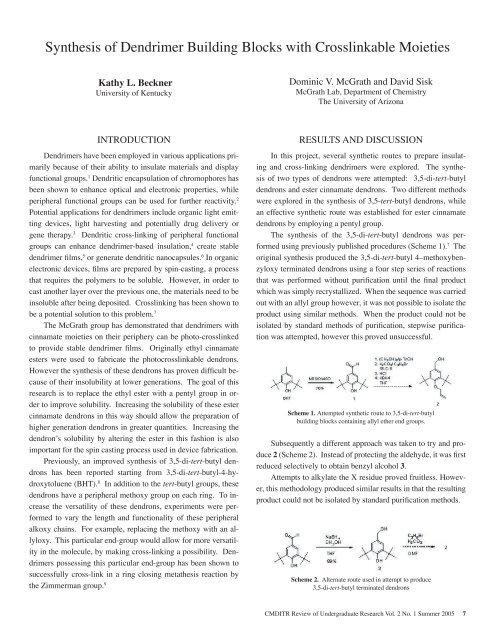Student Project Abstracts 2005 - Pluto - University of Washington
Student Project Abstracts 2005 - Pluto - University of Washington
Student Project Abstracts 2005 - Pluto - University of Washington
Create successful ePaper yourself
Turn your PDF publications into a flip-book with our unique Google optimized e-Paper software.
Synthesis <strong>of</strong> Dendrimer Building Blocks with Crosslinkable MoietiesKathy L. Beckner<strong>University</strong> <strong>of</strong> KentuckyDominic V. McGrath and David SiskMcGrath Lab, Department <strong>of</strong> ChemistryThe <strong>University</strong> <strong>of</strong> ArizonaINTRODUCTIONDendrimers have been employed in various applications primarilybecause <strong>of</strong> their ability to insulate materials and displayfunctional groups. 1 Dendritic encapsulation <strong>of</strong> chromophores hasbeen shown to enhance optical and electronic properties, whileperipheral functional groups can be used for further reactivity. 2Potential applications for dendrimers include organic light emittingdevices, light harvesting and potentially drug delivery orgene therapy. 3 Dendritic cross-linking <strong>of</strong> peripheral functionalgroups can enhance dendrimer-based insulation, 4 create stabledendrimer films, 5 or generate dendritic nanocapsules. 6 In organicelectronic devices, films are prepared by spin-casting, a processthat requires the polymers to be soluble. However, in order tocast another layer over the previous one, the materials need to beinsoluble after being deposited. Crosslinking has been shown tobe a potential solution to this problem. 7The McGrath group has demonstrated that dendrimers withcinnamate moieties on their periphery can be photo-crosslinkedto provide stable dendrimer films. Originally ethyl cinnamateesters were used to fabricate the photocrosslinkable dendrons.However the synthesis <strong>of</strong> these dendrons has proven difficult because<strong>of</strong> their insolubility at lower generations. The goal <strong>of</strong> thisresearch is to replace the ethyl ester with a pentyl group in orderto improve solubility. Increasing the solubility <strong>of</strong> these estercinnamate dendrons in this way should allow the preparation <strong>of</strong>higher generation dendrons in greater quantities. Increasing thedendron’s solubility by altering the ester in this fashion is alsoimportant for the spin casting process used in device fabrication.Previously, an improved synthesis <strong>of</strong> 3,5-di-tert-butyl dendronshas been reported starting from 3,5-di-tert-butyl-4-hydroxytoluene(BHT). 8 In addition to the tert-butyl groups, thesedendrons have a peripheral methoxy group on each ring. To increasethe versatility <strong>of</strong> these dendrons, experiments were performedto vary the length and functionality <strong>of</strong> these peripheralalkoxy chains. For example, replacing the methoxy with an allyloxy.This particular end-group would allow for more versatilityin the molecule, by making cross-linking a possibility. Dendrimerspossessing this particular end-group has been shown tosuccessfully cross-link in a ring closing metathesis reaction bythe Zimmerman group. 9RESULTS AND DISCUSSIONIn this project, several synthetic routes to prepare insulatingand cross-linking dendrimers were explored. The synthesis<strong>of</strong> two types <strong>of</strong> dendrons were attempted: 3,5-di-tert-butyldendrons and ester cinnamate dendrons. Two different methodswere explored in the synthesis <strong>of</strong> 3,5-tert-butyl dendrons, whilean effective synthetic route was established for ester cinnamatedendrons by employing a pentyl group.The synthesis <strong>of</strong> the 3,5-di-tert-butyl dendrons was performedusing previously published procedures (Scheme 1). 7 Theoriginal synthesis produced the 3,5-di-tert-butyl 4–methoxybenzyloxyterminated dendrons using a four step series <strong>of</strong> reactionsthat was performed without purification until the final productwhich was simply recrystallized. When the sequence was carriedout with an allyl group however, it was not possible to isolate theproduct using similar methods. When the product could not beisolated by standard methods <strong>of</strong> purification, stepwise purificationwas attempted, however this proved unsuccessful.Scheme 1. Attempted synthetic route to 3,5-di-tert-butylbuilding blocks containing allyl ether end groups.Subsequently a different approach was taken to try and produce2 (Scheme 2). Instead <strong>of</strong> protecting the aldehyde, it was firstreduced selectively to obtain benzyl alcohol 3.Attempts to alkylate the X residue proved fruitless. However,this methodology produced similar results in that the resultingproduct could not be isolated by standard purification methods.Scheme 2. Alternate route used in attempt to produce3,5-di-tert-butyl terminated dendronsCMDITR Review <strong>of</strong> Undergraduate Research Vol. 2 No. 1 Summer <strong>2005</strong> 7




